Eugene’s own hula school, Na Pua O Hawai’i Nei (The Flowers of Hawai’i), presents its annual ho’ike exhibition June 25 at Cascade Middle School auditorium, 1525 Echo Hollow Road. All classes will perform, from preschoolers through kupuna (elders).
It’s all too easy to dismiss this art form. How many tipsy mainland tourists have watched an overpriced hotel hula show and thought, “What’s the big deal? I could do that.”
Hula, however, is considered a gift from the gods, a sacred form, handed down by Laka or, in other stories, Hi’iaka or Pele. In ancient Hawai’i, the oli (chant) was a basic vessel of culture; chants were used to praise the gods and chiefs, to preserve a story or lineage, and to mark special occasions.
When the missionaries came to the islands in the 1820s, they considered hula an immoral practice and tried to ban it, but it was preserved in the more rural areas. When Kawika (David) Kalakaua, the last king of Hawai’i, took the throne in the 1870s, he sought to rekindle Hawaiians’ pride in their culture. Hula came out of the closet, and big hula performances were a significant part of that.
Hawaiians eagerly adopted the hymn music brought by the missionaries, and before long a musical culture was born: By the late 1800s, Hawaiians were writing their own songs, in their own language. Guitars were introduced in the 1830s and Hawaiians invented their own playing style method of tuning called ki ho’alu, or slack key. The ‘ukulele was introduced around 1880 and, inevitably, a new style of hula evolved called ‘auana, which means “to wander or drift.” It’s what non-Hawaiians are most familiar with today.
Never been to an authentic hula show? Here’s what you can expect:
Hula kahiko is the ancient style and is done to a chant, with a lead percussion played on the ipu heke (large double-gourd) or pahu (large drum). The mood is serious and the dress is usually subdued earth tones, and often made from natural materials.
Hula ‘auana, meanwhile, is the modern style, and is done to either live or recorded songs. The mood is more light-hearted, and can range from fast and rascally to slow and evocative. The dress can be almost anything, usually bright colors with pa’u skirts and blouses for women and trousers and colorful shirts for men. (A typical hula show starts with some kahiko and then has a lot of ‘auana.)
This year’s Na Pua O Hawai’i performance is a tribute to Kamehameha the Great, first king of Hawai’i. Doors open at 1 pm for the 2 pm show; $10 ages 10 and up, $5 for ages 5-9, free for ages 4 and under. (And there will be food available, and shave ice.)
Earlier the same day, Dance Northwest sponsors a workshop with Kumari Suraj, who specializesin waacking, house, vogue, hip hop, Afro-fusion, Frankie Douglas and twerk styles of dance. Suraj has appeared on and choreographed for FOX’s So You Think You Can Dance; she’s the founder and CEO of the International Waack/Punk/Pose Festival in Los Angeles, and director of the internationally known dance companies The Waackers and Jungle Jills. The performance takes place in the LCC Dance Studio, Building 5, Room 136, 10 to 11:30 am; $20-$25.
And if you fancy a road trip, head to Portland to explore its modern dance history. “How do today’s dancers stand on the shoulders of decades of Portland dancers and choreographers who established this community?” asks filmmaker Eric Nordstrom, who presents a work-in-progress showing of the first comprehensive film to address dance history in Portland.
As part of the evening, a collection of dance films by Portland filmmakers will also be shown, including Carolyn Altman and Bonnie Merrill’s Off Location, Waking the Green Sound by Wobbly’s Yulia Arakelyan, and Erik Ferguson and Carla Mann’s Ching. Film screening 8 pm June 25 at Performance Works NW.
And looking ahead: DanceAbility International offers a DanceAbility Teacher Certification Course Aug. 7 through Sept. 2. And The Northwest Screendance Exposition accepts submissions until Aug. 15; more info at nwscreendanceexpo.com.
